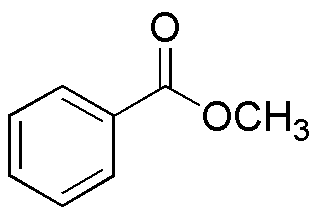Methyl benzoate is widely utilized in research focused on:
- Fragrance Industry: Commonly used as a flavoring and fragrance agent in perfumes and cosmetics, providing a sweet, floral aroma that enhances product appeal.
- Pharmaceuticals: Serves as a solvent and intermediate in the synthesis of various pharmaceutical compounds, improving drug formulation and stability.
- Food Industry: Employed as a flavoring agent in food products, offering a pleasant taste profile that can enhance consumer enjoyment.
- Polymer Production: Acts as a plasticizer in the formulation of polymers, improving flexibility and durability in materials used for packaging and construction.
- Research Applications: Used in organic synthesis and as a model compound in studies related to esterification and reaction kinetics, aiding in the understanding of chemical processes.
General Information
Properties
Safety and Regulations
Applications
Methyl benzoate is widely utilized in research focused on:
- Fragrance Industry: Commonly used as a flavoring and fragrance agent in perfumes and cosmetics, providing a sweet, floral aroma that enhances product appeal.
- Pharmaceuticals: Serves as a solvent and intermediate in the synthesis of various pharmaceutical compounds, improving drug formulation and stability.
- Food Industry: Employed as a flavoring agent in food products, offering a pleasant taste profile that can enhance consumer enjoyment.
- Polymer Production: Acts as a plasticizer in the formulation of polymers, improving flexibility and durability in materials used for packaging and construction.
- Research Applications: Used in organic synthesis and as a model compound in studies related to esterification and reaction kinetics, aiding in the understanding of chemical processes.
Documents
Safety Data Sheets (SDS)
The SDS provides comprehensive safety information on handling, storage, and disposal of the product.
Product Specification (PS)
The PS provides a comprehensive breakdown of the product’s properties, including chemical composition, physical state, purity, and storage requirements. It also details acceptable quality ranges and the product's intended applications.
Certificates of Analysis (COA)
Search for Certificates of Analysis (COA) by entering the products Lot Number. Lot and Batch Numbers can be found on a product’s label following the words ‘Lot’ or ‘Batch’.
*Catalog Number
*Lot Number
Certificates Of Origin (COO)
This COO confirms the country where the product was manufactured, and also details the materials and components used in it and whether it is derived from natural, synthetic, or other specific sources. This certificate may be required for customs, trade, and regulatory compliance.
*Catalog Number
*Lot Number
Safety Data Sheets (SDS)
The SDS provides comprehensive safety information on handling, storage, and disposal of the product.
DownloadProduct Specification (PS)
The PS provides a comprehensive breakdown of the product’s properties, including chemical composition, physical state, purity, and storage requirements. It also details acceptable quality ranges and the product's intended applications.
DownloadCertificates of Analysis (COA)
Search for Certificates of Analysis (COA) by entering the products Lot Number. Lot and Batch Numbers can be found on a product’s label following the words ‘Lot’ or ‘Batch’.
*Catalog Number
*Lot Number
Certificates Of Origin (COO)
This COO confirms the country where the product was manufactured, and also details the materials and components used in it and whether it is derived from natural, synthetic, or other specific sources. This certificate may be required for customs, trade, and regulatory compliance.


